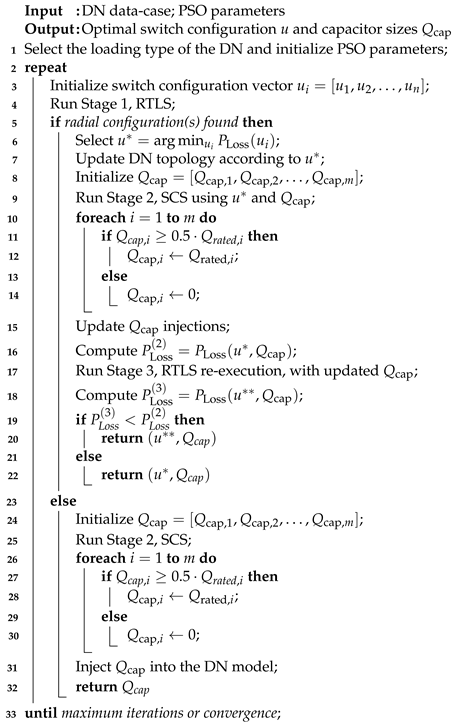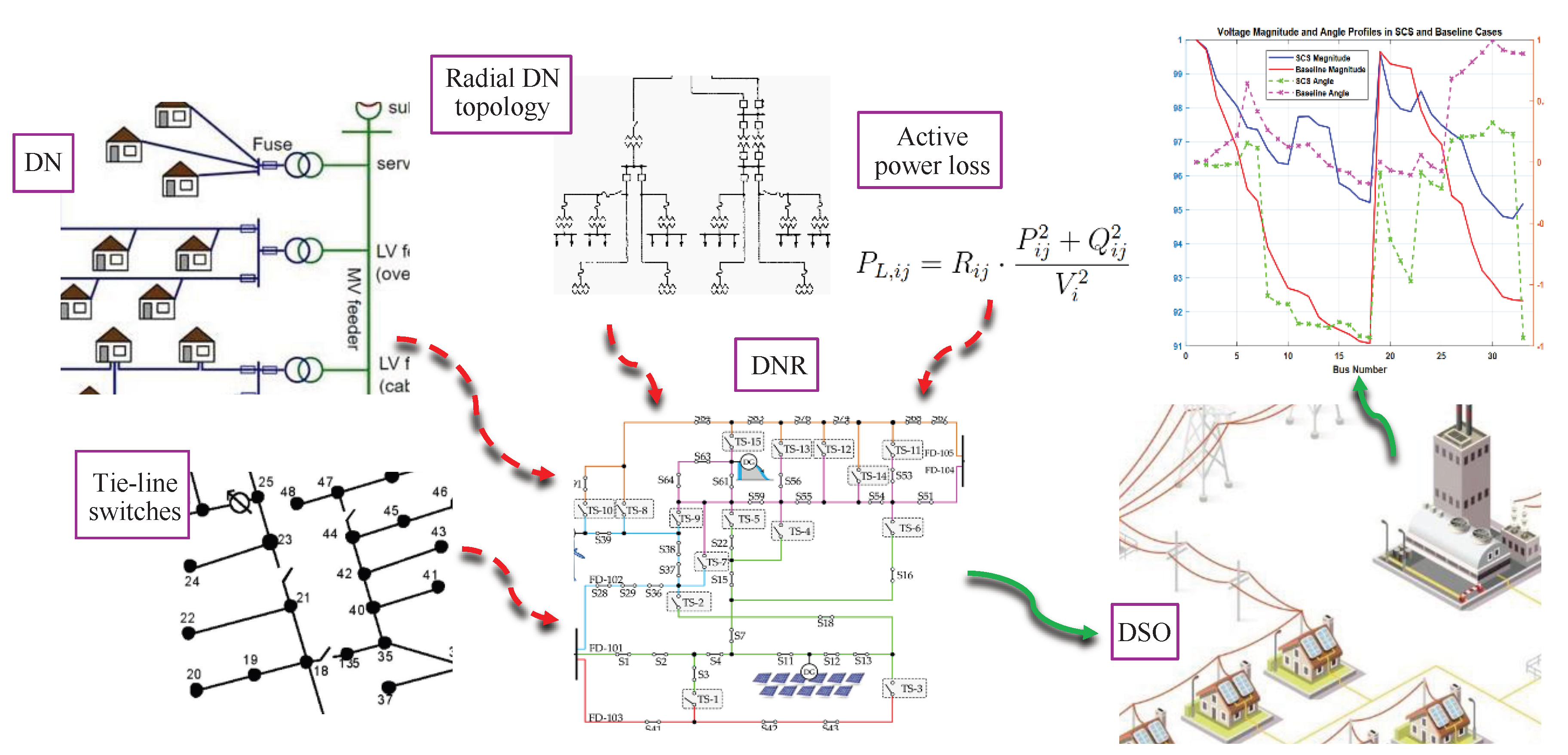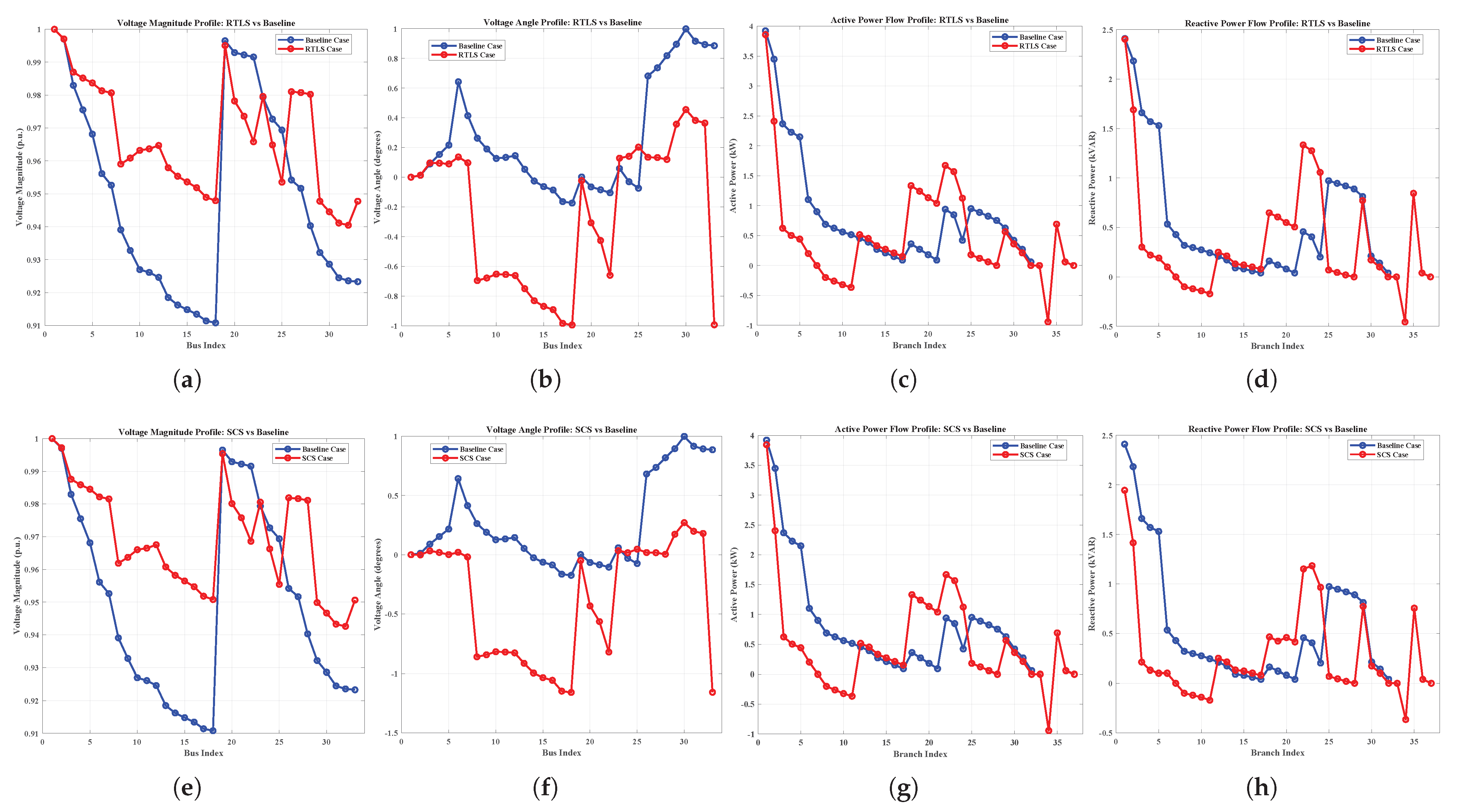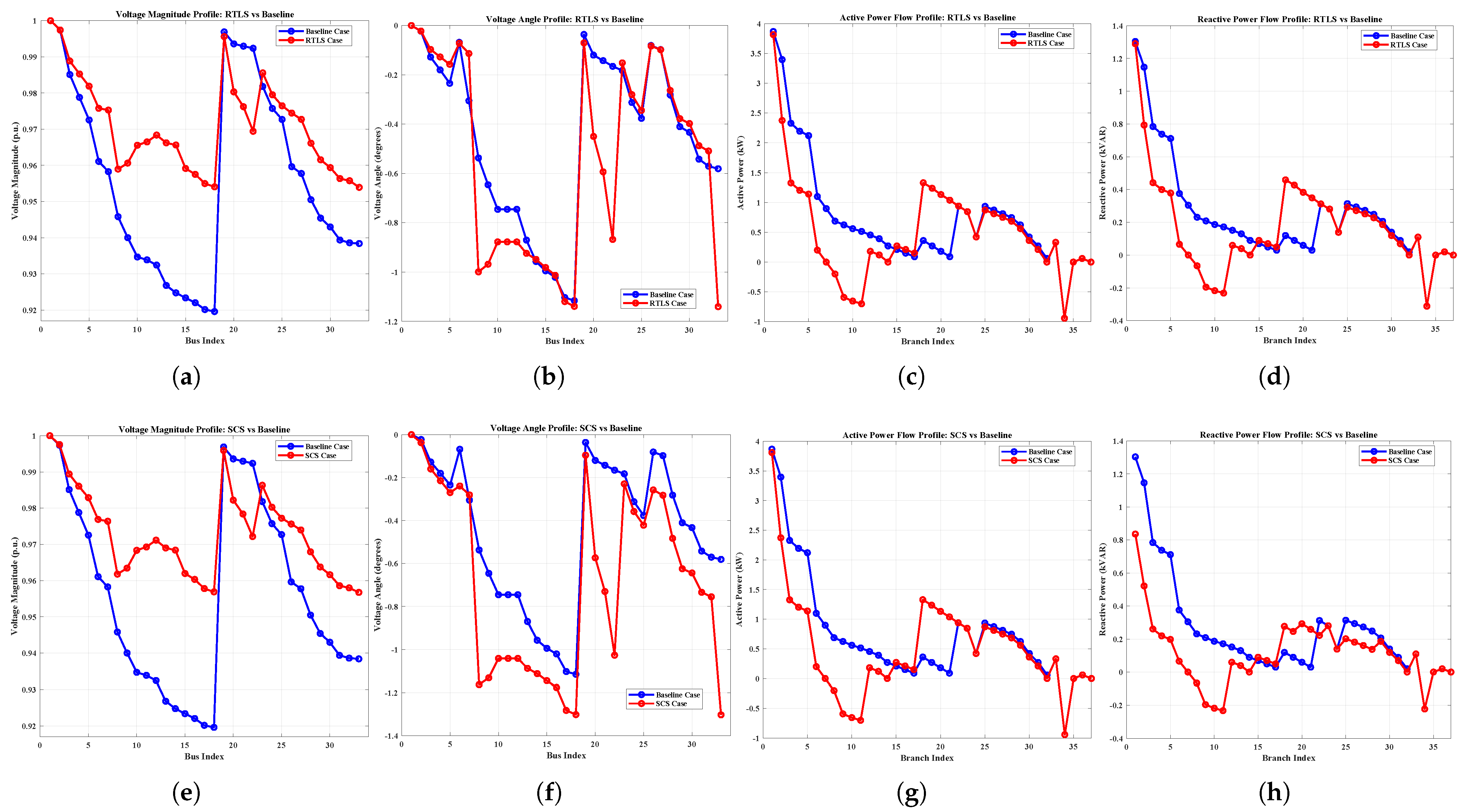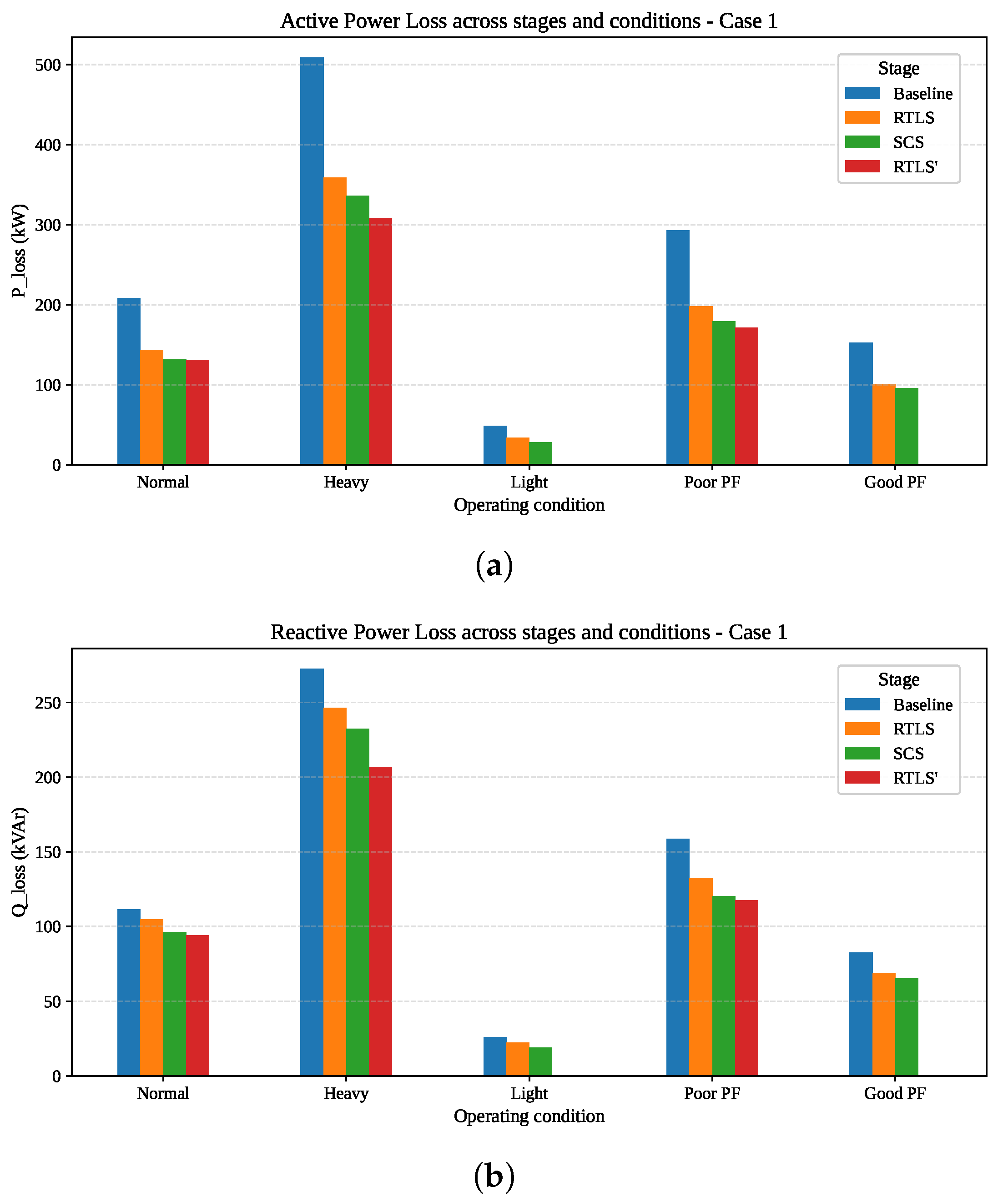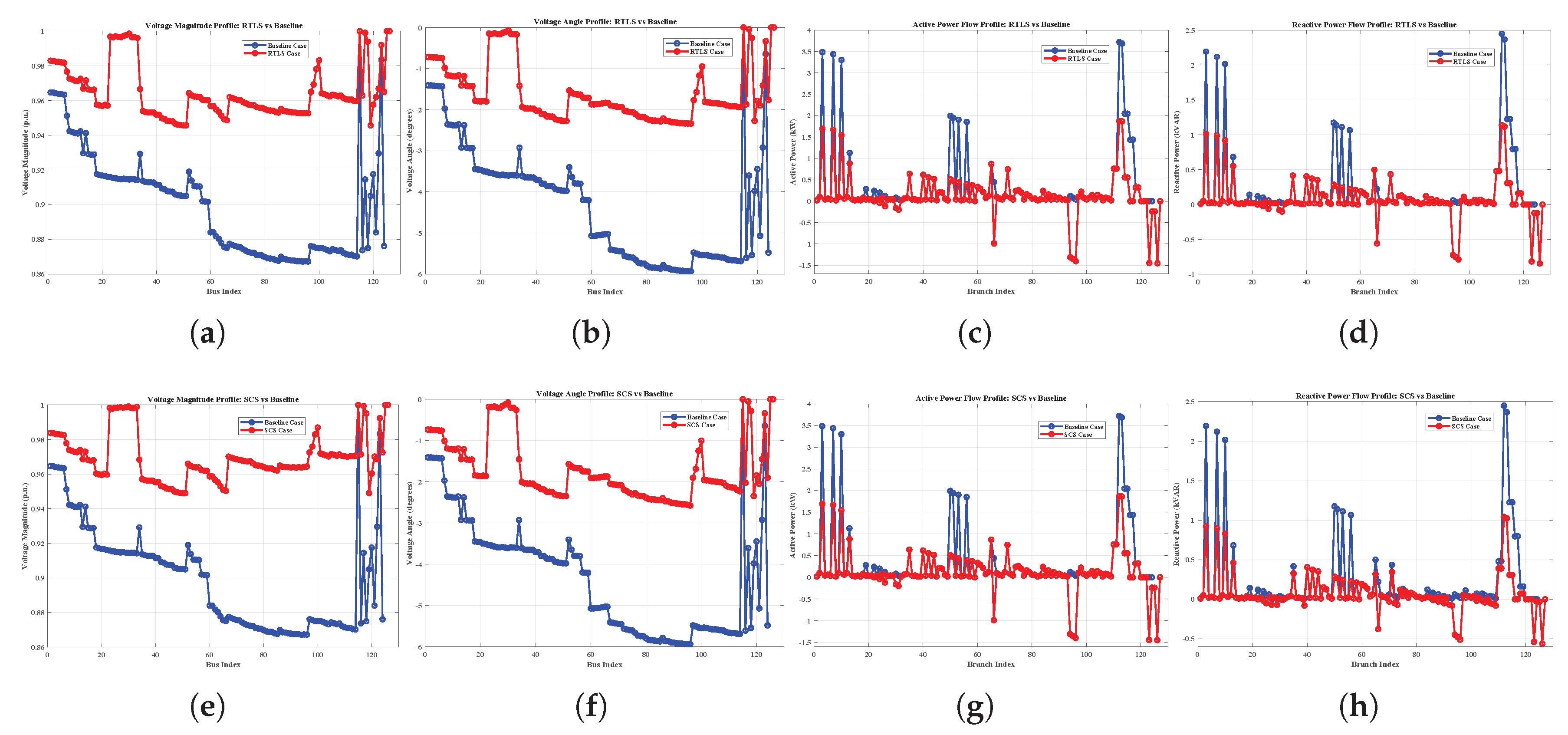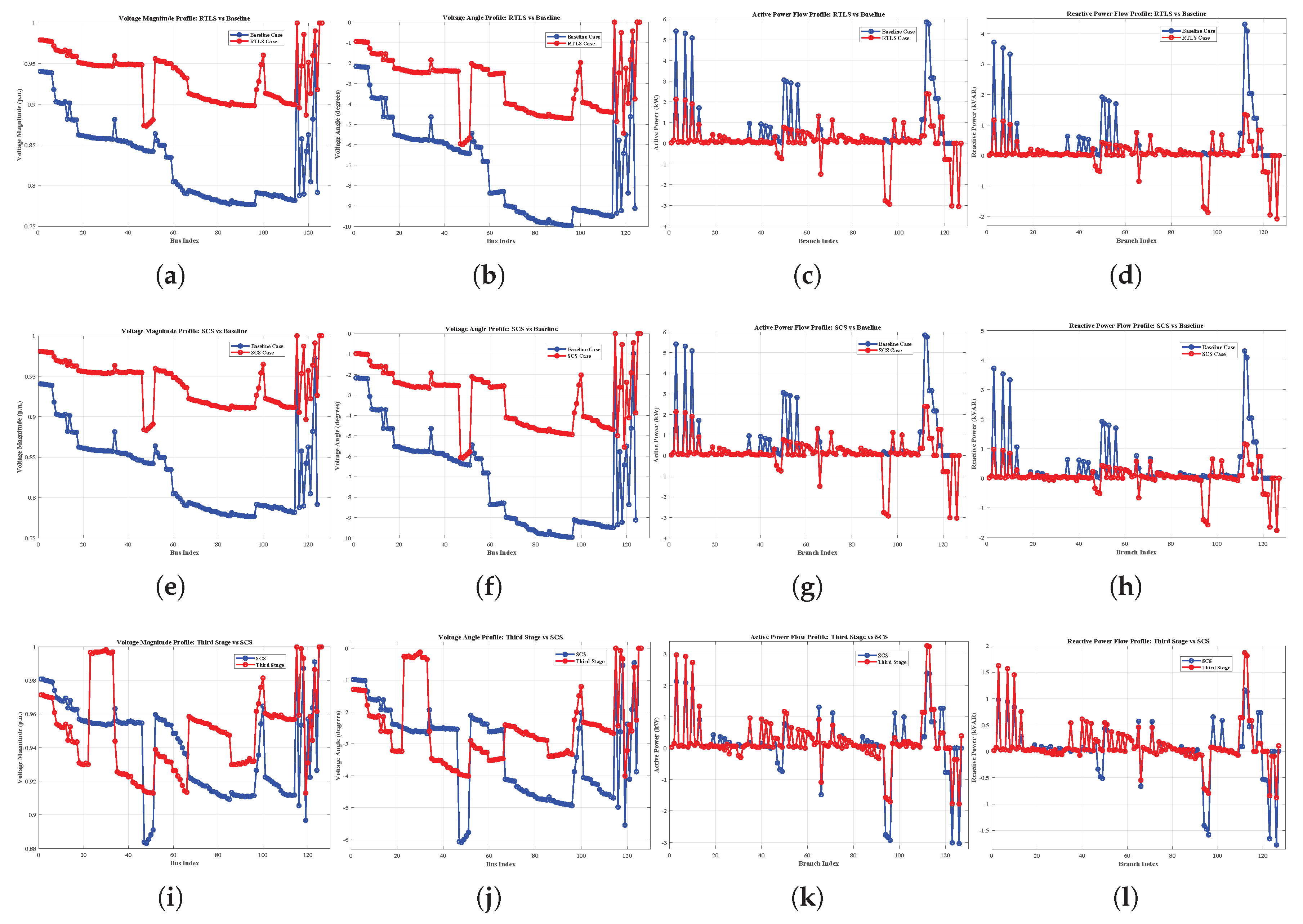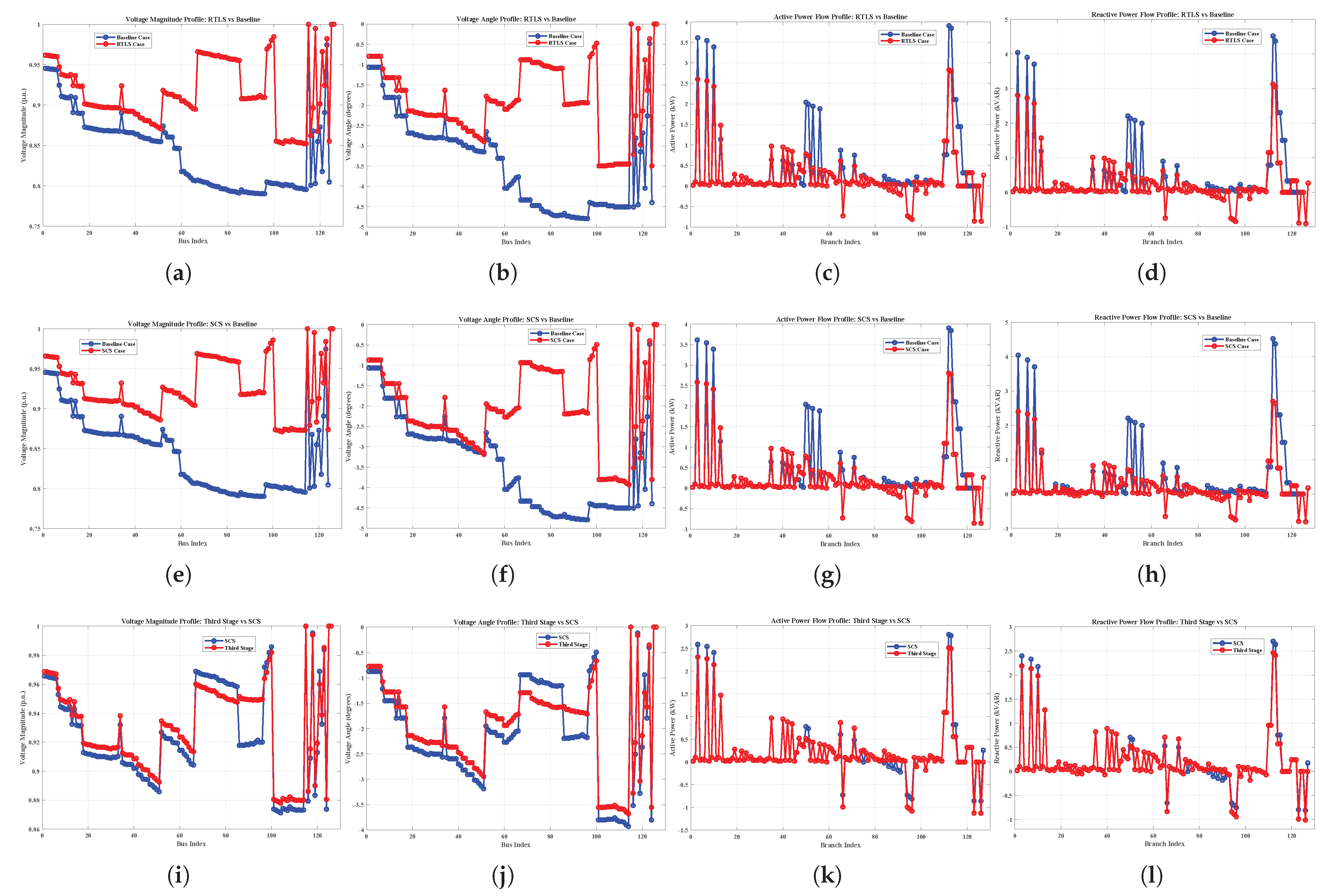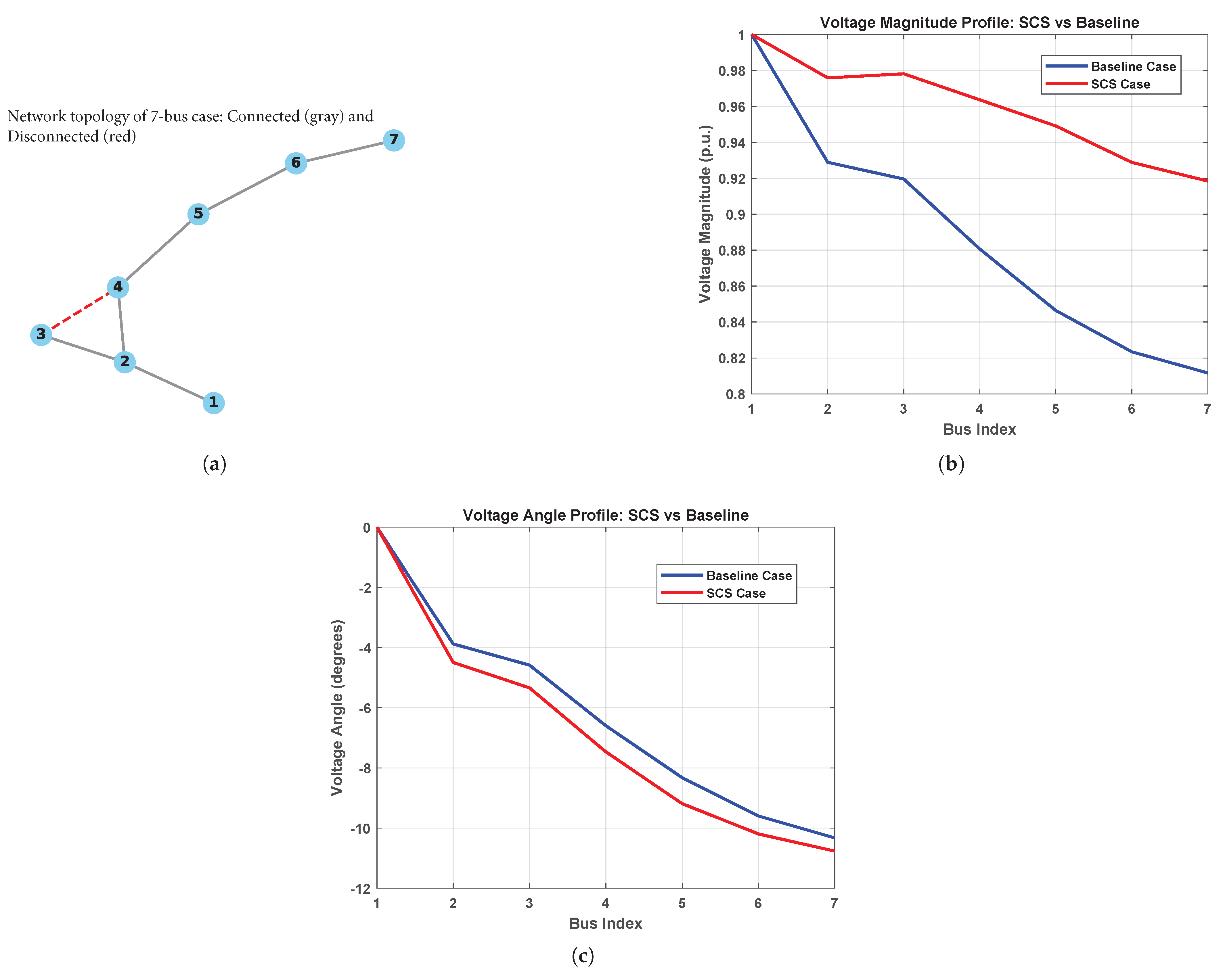Distribution Network Reconfiguration (DNR) is increasingly central as Distributed Energy Resources (DERs) reshape distribution operations. While DERs advance sustainability and decentralization [
1], their intermittency introduces bidirectional flows and voltage rise and raises power quality concerns [
2]. Without targeted control, high DER penetration aggravates losses and voltage deviations [
3,
4]. DNR addresses these issues by altering topology via tie-line switching to reduce losses, improve voltage profiles, and expand renewable hosting capacity [
5]. It also enhances distribution system operator (DSO) flexibility, enabling real-time responses to congestion and variability and deferring costly reinforcements through better use of existing assets [
6]. As demonstrated in
Figure 1, DNR changes the radial topology of a DN by operating tie-line switches. The goal is to reduce feeder active power losses and improve bus voltage profiles while keeping the network radial and within operational limits. The DSO uses this technical flexibility approach [
7] in real-time or day-ahead operation strategies to adapt the DN to load and generation conditions.
Literature Review
The concept of DNR was first introduced for meshed networks using Kirchhoff’s second law in [
8], aiming to minimize active power losses by identifying optimal radial topologies. A compensation-based power flow technique to reduce line losses was later proposed in [
9]. Building upon this, ref. [
10] formulated a mathematical approach to feeder reconfiguration using search-based methods, while [
11] contributed approximate power flow models tailored for reconfiguration tasks. Evolutionary computation began entering the field in [
12], where Genetic Algorithms (GAs) were applied to solve the loss minimization problem under a mixed-integer framework. Similarly, ref. [
13] implemented a Simulated Annealing method for line loss reduction using simplified load flow models. More recent work has explored advanced metaheuristic methods: ref. [
14] introduced a heap-based structure to enhance voltage profiles and reduce losses, and ref. [
15] proposed a Shark Smell Optimization algorithm aimed at improving reliability and voltage stability.
The inclusion of high-penetration Renewable Energy Sources (RESs) in DNs increases the complexity of DNR, especially due to their intermittent behavior. Reconfiguration decisions alter tie-line switch statuses and impact backup power management and grid dynamics. Consequently, the use of accurate AC power flow models has been recommended [
16,
17,
18], as they closely reflect the physical behavior of real-world systems. However, combining continuous AC flow equations with binary switch status variables transforms the DNR problem into a Mixed-Integer Nonlinear Programming (MINLP) challenge. A variety of solution methodologies have been proposed, including stochastic [
19], deterministic [
20], and robust optimization [
21], as well as Second-Order Cone Programming (SOCP) relaxations [
22,
23], and branch-and-bound [
24]. Model Predictive Control (MPC) has also been applied for adaptive reconfiguration under uncertainty [
25].
Several heuristic approaches have been developed to handle the combinatorial nature of DNR. These include classic and modified GAs [
26], Particle Swarm Optimization (PSO) variants [
27], and novel techniques such as the
-bat algorithm [
28], branch current matrix methods [
29], and the Firefly algorithm [
30]. Each method aims to reduce power losses, enhance voltage profiles, or both—offering trade-offs in accuracy and computational efficiency. Beyond energy efficiency, DNR has been used to improve power quality metrics. A non-iterative Harmonic Load Flow (HLF) method is proposed in [
31] to address harmonic distortions in capacitor-compensated networks. Similarly, refs. [
32,
33] apply discrete PSO techniques to minimize voltage flicker, balance voltages, and reduce power losses under varying load conditions. The integration of DERs and RESs has motivated new DNR strategies. In [
34], an Ant Lion Optimizer is used to minimize operational costs under RES uncertainty. Ref. [
35] explores the Selective Bat Algorithm for both balanced and unbalanced networks. Ref. [
36] presents a dynamic DNR approach incorporating RESs, energy storage, and electricity price variability, validated on the IEEE 95-bus system.
Several studies have explored hybrid algorithms that merge the strengths of multiple metaheuristics. Ref. [
37] combines binary PSO with conventional PSO for joint DNR and DG placement. A hybrid PSO–ACO model is proposed in [
38], and further comparisons between PSO, GA, and exhaustive search are made in [
39]. PSO-based frameworks integrating DG sizing are also demonstrated in [
40,
41]. Harmony Search Algorithms (HSA) are employed in [
42] to jointly optimize DNR and DG placement while satisfying operational constraints. Addressing uncertainty and operational cost, ref. [
43] proposes a scenario-based stochastic framework for RES-integrated microgrids. Ref. [
44] considers the impact of electric vehicles on tie-line switching, and ref. [
45] optimizes scheduling and reconfiguration jointly using PSO while incorporating demand response and protection costs. Ref. [
46] analyzes DNR frequency and switching replacement strategies across different time scales. In [
47], dynamic DNR is combined with power electronics to maximize hosting capacity. Refs. [
48,
49] develop optimization frameworks to enhance HC in RES-rich environments using DNR, OLTCs, and DG allocation. Refs. [
50,
51] explore unbalanced operation scenarios with reported reductions in power losses by 12% and 25%, respectively. The work in [
52] integrates photovoltaic generation with STATCOMs and reconfiguration, tested on the IEEE 33-bus system. To address challenges from increasing EV and DG integration, ref. [
53] proposes a stochastic DNR approach using PDFs and Monte Carlo simulations, achieving loss minimization and operational efficiency across varying EV/DG penetration levels. A fault recovery strategy for DC networks is introduced in [
54], utilizing EV discharging and Soft Open Points (SOPs) within a two-tier optimization framework, ensuring load restoration and minimized losses under post-disaster scenarios.
Recent work combines DG siting/sizing with DNR to jointly reduce losses and improve voltage regulation. The Electric Eel Foraging Optimization achieves strong loss and voltage gains on 33- and 84-bus feeders and outperforms Zebra and Whale optimizers while requiring no parameter tuning [
55]. A graph-theory-enhanced Adaptive Mountain Gazelle Optimizer co-optimizes reconfiguration and PV DG placement and improves stability, cost, and emissions on IEEE 33 and 69 buses [
56]. Improved radiality maintenance with IRMA and hybrid GA–TLBO and TLBO–GA delivers faster convergence and lower losses and voltage deviations across benchmarks [
57]. Hippopotamus Optimization for DG–DNR under voltage-dependent loads surpasses standalone DG planning on large systems [
58]. A distributed ADMM formulation decomposes DNR across agents while preserving radiality and scales to standard and real networks [
59]. A Simulated Annealing framework with reactive compensation models hourly variability with BESS and DG under operational limits [
60]. A Selective PSO implementation on a 125-bus Indonesian feeder improves voltage and reduces losses across load scenarios, supporting practical feasibility [
61].
Recent studies have emphasized hybrid optimization strategies that integrate distributed generation (DG) allocation with DNR for improved efficiency and voltage regulation. The Electric Eel Foraging Optimization (EEFO) algorithm introduces adaptive search behaviors and parameter-free tuning, achieving substantial loss reduction and voltage improvements in 33- and 84-bus networks, outperforming other metaheuristics like Zebra and Whale optimizers [
55]. Similarly, a graph-theory-enhanced Adaptive Mountain Gazelle Optimizer (AMGO) is developed to jointly optimize reconfiguration and photovoltaic DG placement, delivering enhanced voltage stability and cost-effectiveness while significantly reducing emissions in the IEEE 33- and 69-bus systems [
56]. An improved radiality maintenance framework using IRMA, along with two hybrid metaheuristic schemes (GA-TLBO and TLBO-GA), shows superior convergence and stability across benchmark systems by effectively minimizing power losses and voltage deviations [
57]. Another novel approach employs the Hippopotamus Optimization Algorithm (HOA) for DG-DNR co-optimization under voltage-dependent load models, demonstrating marked improvements over standalone DG planning across large-scale systems [
58]. A distributed ADMM-based method for DNR is proposed in [
59], decomposing the optimization problem across agents while maintaining radial topology, validated on both standard and real-world networks. In parallel, ref. [
60] formulates a realistic DNR framework incorporating reactive power compensation using Simulated Annealing, addressing hourly variations in load and generation with BESS and DG under operational constraints. Additionally, a Selective PSO method applied to a 125-bus Indonesian network under various load scenarios effectively enhances voltage profiles and reduces power losses, reinforcing the method’s practical feasibility [
61].
Recent work applies Deep Reinforcement Learning (DRL) to DNR for adaptive operation under both normal and faulted conditions. RDDNR enables real-time reconfiguration and fast post-fault restoration, which strengthens resilience and service continuity [
62]. A multi-agent DRL scheme for urban networks introduces a switch-contribution metric and a two-stage learning design with reward sharing and an improved QMIX, and it scales to a 297-node practical system [
63]. A bi-level, data-driven Volt/Var Control formulates continuous PV control and discrete reconfiguration as a POMDP, combines TD3 and DDQN, and uses graph neural networks to compress the topology space, achieving stronger voltage regulation on IEEE 33- and 69-bus feeders [
64]. Also, authors proposed a dynamical sequential DNR approach using DRL in [
65].
Despite advancements in DNR, existing methods often suffer from oversimplified modeling (e.g., DC or linearized AC power flow), limited scalability, and a lack of adaptability under dynamic grid conditions. To address these challenges, this paper introduces a robust three-stage optimization framework for DNR that integrates network reconfiguration and reactive power support, leveraging full AC power flow modeling for accuracy. The proposed method is validated on the IEEE 33-bus, the IEEE 123-bus, and a custom 7-bus system. To examine robustness and applicability, the methodology is tested under five realistic conditions: heavy loading, light loading, normal loading, poor power factor (PF), and good PF scenarios. The core contributions of the paper are as follows:
A modular three-stage design that decouples reconfiguration from reactive compensation while preserving radiality.
A DFS-augmented PSO in the initial and feedback stages that enforces connectivity and minimizes active power losses.
A feedback stage that conditionally refines topology using updated reactive profiles when further gains are possible.
Full AC power-flow modeling throughout and comprehensive validation on IEEE 33/123 and a 7-bus system under five operating conditions, demonstrating scalability and robustness.
The remainder of the paper presents the methodology and solution procedure in
Section 2,
Section 3 presents the case study, numerical results are provided in
Section 4, and finally,
Section 5 concludes the paper.
